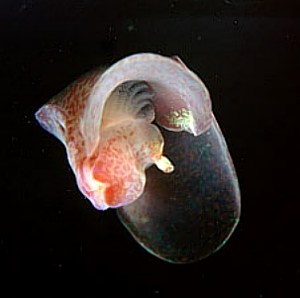
Gastropteron pacificum
Bergh, 1894
Order: CEPHALASPIDEA
Superfamily: PHILINOIDEA
Family: Gastropteridae
DISTRIBUTION
West coast of North America from Alaska to Gulf of California.
PHOTO
Howe Sound, near Vancouver, British Columbia, [Canada]. Appprox 2 cm. long. Photo: Marli Wakeling.
Translucent cream with pinkish red specks, this cephalaspid opisthobranch, like all members of the Gastropteridae, is able to swim quite vigorously by flapping its greatly enlarged parapodial flaps. These parapodia are lateral extensions of the foot. Behrens (1991) records this species from the intertidal to about 1400 feet [approx 500m].
Reference:
• Bergh, R. (1894). Reports on the dredging operations off the west coast of central America to the Galapagos, to the west coast of Mexico, and in the Gulf of California, in charge of Alexander Agassiz, carried on by the U.S. Fish Commission Steamer "Albatross", during 1891, Lieut. Commander Z.L. Tanner, U.S.N., Commanding. Part 13. Die Opsthobranchien. Bulletin of the Museum of Comparative Zoology, 25(10): 125-233
Rudman, W.B., 2001 (February 18) Gastropteron pacificum Bergh, 1894. [In] Sea Slug Forum. Australian Museum, Sydney. Available from http://www.seaslugforum.net/find/gastpaci
Related messages
Gastropteron pacificum swimming
November 23, 2007
From: Jan Kocian
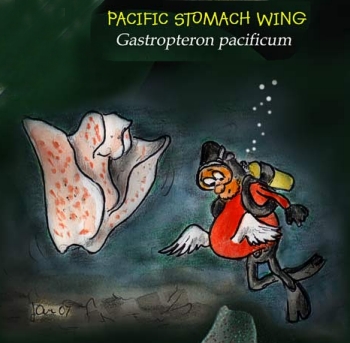
Re: Message #21158
Dear Bill.
I found this Gastropteron pacificum flapping its way through water column. Trying to capture the tiny slug as it busily moves around is a real challenge with a point & shoot camera with its shutter delay.
Locality: Holmes Harbor, Whidbey Island, 10 feet, Washington, USA, Eastern North Pacific, 22 October 2007, near Eel grass bed. Length: 12 mm. Photographer: Jan Kocian.
Jan Kocian
honkoc@hotmail.com
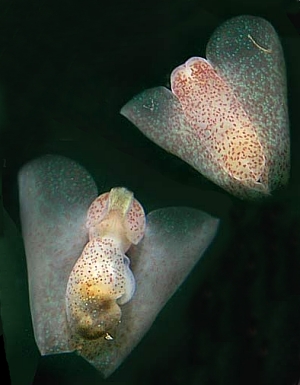
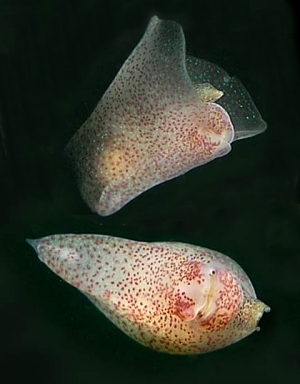
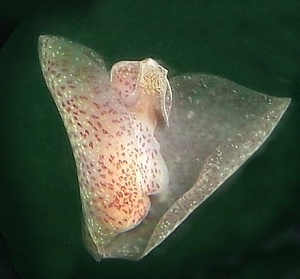
Dear Jan,
Thanks for the great photos - and the humour
Best wishes,
Bill Rudman
Gastropteron pacificum - locomotion
November 22, 2007
From: Lily McLean
Dear Bill,
We have recently collected several individuals of Gastropteron pacificum, from a dredge in Barkley Sound on the west coast of Vancouver Island, Canada. We have been working on a project examining the biomechanics of their locomotion, and we have had trouble finding information. We were hoping you could tell us anything you know about locomotion in Gastropteron, or any similar cephalaspids.
Locality: Bamfield, ?, British Columbia, Canada, Pacific Ocean, 13 November 2007, Dredged. Length: 1 - 2 cm
Thanks alot,
Lily Mclean and Erika Simonson
Bamfield Marine Sciences Center
PS. We love your sea slug forum!
lilym@uvic.ca
McLean, L., 2007 (Nov 22) Gastropteron pacificum - locomotion. [Message in] Sea Slug Forum. Australian Museum, Sydney. Available from http://www.seaslugforum.net/find/21158Dear Lily & Erika,
I have a Fact Sheet on swimming but I am afraid at present it just contains a list of references - although it does have a composite photo of Sagaminopteron ornatum swimming. Haefelfinger & Kress (1967) analysed the swimming behaviour of the Mediterranean Gasteropteron rubrum by meticulously studying a film of it swimming, frame by frame. Wes Farmer's summary swimming in gastropods (1970) may be more accessible to you as it was published in The Veliger.
The name Gastropteron, which basically means 'stomach on wings' is quite appropriate. Quite a few unrelated opisthobranchs have evolved wing-like extensions on the sides of their foot - which we call parapodia - and quite a few of them have adapted them for swimming, including many species of Aplysia [see A. fasciata, A. brasiliana], Akera [see Akera bullata] as well as species of the Gastropteridae. We don't know what the function of swimming is in various species. Perhaps it is just an escape mechanism when they are disturbed, or perhaps in some species it is an important means of locomotion.
If by chance you have photos of this species swimming, they would be a nice addition to the Forum
- Farmer, W. M. (1970) Swimming gastropods (Opisthobranchia and Prosobranchia). The Veliger 13(1): 73-89.
- Haefelfinger, H-R. & Kress, A. (1967) Der Schwimmvorgang bei Gasteropteron rubrum (Rafinesque 1814) (Gastropoda, Opisthobranchiata). Revue Suisse de Zoologie, 74: 547-554.
Best wishes,
Bill Rudman
Benthic behaviour Gastropteron pacificum
March 23, 2007
From: Jackie Hildering
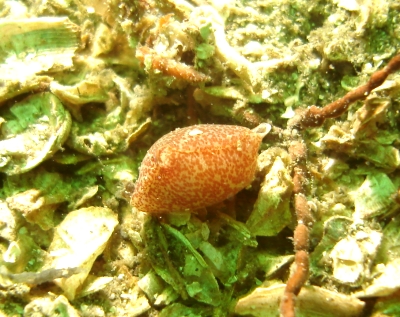
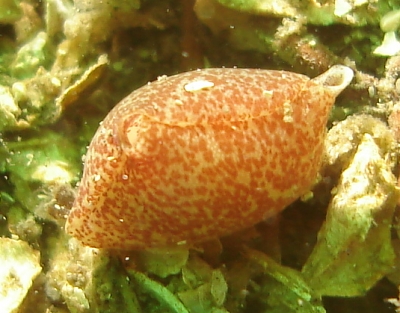
Hello Bill,
Saw 16 different nudibranch species on this shore dive today. One of many highlights was seeing +/- 7 Gastropteron pacificum "swimming." I had the good fortune to be able to track one animal as it settled to the bottom and got this photo. Any information about the "oral groove like" structure protruding from its anterior end would be much welcomed.
Locality: Bear Cove - Port Hardy, 40 ft, British Columbia, Canada, Pacific Ocean, 20 March 2007, mud bottom. Length: 2 cm. Photographer: Jackie Hildering.
Jackie
earthlingenterprises@telus.net
Hildering, Jackie, 2007 (Mar 23) Benthic behaviour Gastropteron pacificum. [Message in] Sea Slug Forum. Australian Museum, Sydney. Available from http://www.seaslugforum.net/find/19738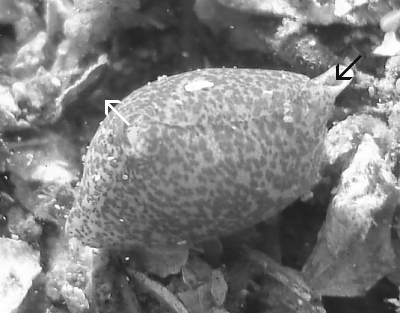
Dear Jackie,
Thanks for this interesting photo. Sitting like this, the Gastropteron looks quite like a little bivalve with an anterior inhalent siphon drawing water into the mantle cavity and a posterior exhalant siphon expelling 'used' water. Functionally, that is exactly what is happening, but anatomically it is a bit different.
If you look at photos of Gastropteron chacmol [see #12363] you will see that gastropterids have a head shield with a pointed crest in the posterior midline which is folded into a tube, or siphon. The many photos of Siphopteron flavum on the Forum also give a good idea of the general shape of gastropterids. The back half of the gastropterid body contains the body organs, and the remnants of the shell, mantle cavity and gills. In many ways it is similar in layout to the sea hares [see Fact Sheet ]. In both groups the large parapodia, which can act as swimming organs, can also wrap around the body enclosing the shell, gills etc in a large water-filled cavity. The 'oral groove like structure' you ask about is the siphon which I mentioned above, on the back of the head shield. It acts as an inhalent siphon directing water down into the water-filled cavity formed by the parapodia. You will note that I do not call this cavity a 'mantle cavity' because it is not. All that remains of the true mantle cavity in both these animals, and sea hares, is the small crowded space beneath the remnant shell in which the gill is hidden. [For more on mantle cavities see Torsion Fact Sheet].
Your Gastropteron is one of the largest species in the family. At present we have no idea what any species feeds on, so this species might be easier than many to catch feeding. Can you put it on your 'to do' list? It would be very interesting to know. I know of no identifiable stomach contents being reported so I suspect they may feed on small flatworms or other invertebrate with no hard parts - but that is just a guess.
Best wishes,
Bill Rudman
Gastropteron pacificum from British Columbia
February 19, 2001
From: Marli Wakeling

Here's something a bit different! This is Gastropteron pacificum, also known as a 'winged sea slug', and is found flapping it's two wing like projections to swim. The gills are on the right side of the body, and you can see the gill leaflets in the photo. It is usually a yellow colour with red markings. This specimen was found in Howe Sound, near Vancouver, British Columbia, [Canada]. It is about 2 cm. in length.
Marli
scubamarli@excite.com
Wakeling, M., 2001 (Feb 19) Gastropteron pacificum from British Columbia. [Message in] Sea Slug Forum. Australian Museum, Sydney. Available from http://www.seaslugforum.net/find/3827Thanks Marli,
Quite a spectacular photo of it swimming. For anyone unfamiliar with members of the Gastropteridae, have a look at the photos of Sagaminopteron ornatum. Gastropterids have very large lateral extensions of the foot, called parapodia, which can flap vigorously, enabling the animal to swim, a bit like an out-of-control butterfly. This photo is looking at the animal head on.
A literal translation of the name 'gastropteron' would be 'winged stomach', which I am glad to say has not become a widely used common name.
Bill Rudman
